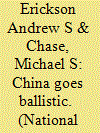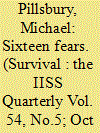| Srl | Item |
| 1 |
ID:
133795


|
|
|
|
|
| Publication |
2014.
|
| Summary/Abstract |
China's growing missile and nuclear forces will pose a complex, challenging threat to America and its allies.
CHINA IS INCREASINGLY A FORCE TO BE RECKONED WITH, not only economically but also militarily. Its aggressive stance toward some of its neighbors, along with Asia's growing economic importance and the need to assure U.S. allies that Washington will increase its attention to the region despite budgetary challenges and fractious domestic politics, prompted the Obama administration to announce a "rebalance" toward Asia.
|
|
|
|
|
|
|
|
|
|
|
|
|
|
|
|
| 2 |
ID:
184892


|
|
|
| 3 |
ID:
129851


|
|
|
|
|
| Publication |
2014.
|
| Summary/Abstract |
This article seeks to place recent developments in China in a larger context through three arguments. First, Chinese military policy has indeed made a major turning over the past decade; second, this turning is based on a fragile and unrealistic strategy that is already eliciting counterreactions that will make achievement of its apparent goals increasingly difficult. Finally, this strategy's failure will present China with unwelcome choices about how far to take her use of force. The "rise" of China is now encountering turbulence that may undo it.
|
|
|
|
|
|
|
|
|
|
|
|
|
|
|
|
| 4 |
ID:
115195


|
|
|
|
|
| Publication |
2012.
|
| Summary/Abstract |
During the Cold War, an influential group of American defence planners sought to understand Soviet defence decisions by grasping the Soviet mind, including exploring how the Soviet generals thought about war and their opponents. This was achieved only through intensive intelligence collection and intellectual analysis, including extensive use of open sources. It was a process which, as George Kennan put it in his analysis of Soviet thinking, 'would require living with contradictions'.
|
|
|
|
|
|
|
|
|
|
|
|
|
|
|
|